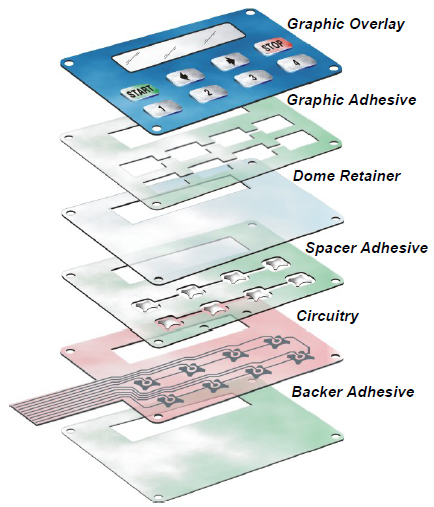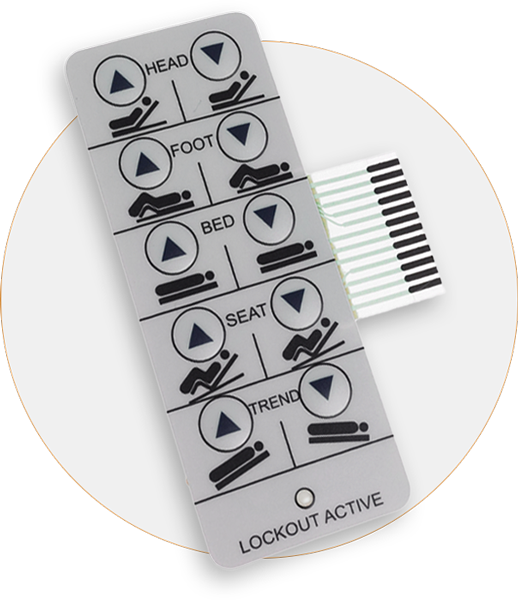A well-known membrane switch manufacturer offers both trial and large-scale options.
A well-known membrane switch manufacturer offers both trial and large-scale options.
Blog Article
Everything About Membrane Layer Switch: Comprehending Its Style and Functionality
When you believe about the control user interfaces in modern gadgets, membrane switches typically come to mind. Allow's explore what sets membrane layer switches over apart from other control systems.
What Are Membrane Layer Switches?

Membrane layer switches can also be customized regarding form, dimension, and graphics, enabling makers to create unique user interfaces tailored to specific items. Overall, membrane layer buttons play a considerable duty in enhancing customer experience across a broad selection of applications.
How Membrane Changes Job
When you press a trick on a membrane layer button, it turns on a simple yet effective device. The top layer, often made from adaptable material, lowers onto a conductive layer beneath it. This action bridges the void in between conductive traces, completing an electrical circuit. As quickly as the circuit shuts, it sends out a signal to the gadget's controller, which analyzes your input.
You'll observe that the responsive feedback differs based on the switch layout, supplying either a soft click or an extra pronounced reaction. As soon as you release the secret, the membrane returns to its initial placement, resuming the circuit and stopping the signal. This process takes place almost instantly, making sure a receptive customer experience.
Membrane buttons are preferred due to their sturdiness and resistance to dust and dampness, making them perfect for numerous applications, from house home appliances to medical gadgets. Understanding this operation helps you value their widespread usage.
Key Elements of Membrane Buttons
Understanding the key parts of membrane switches is fundamental for grasping their functionality and design. The safety layer guards versus ecological factors and wear, expanding the switch's life-span. By recognizing these components, you'll gain understanding right into exactly how membrane layer changes run and their importance in different applications.
Materials Made Use Of in Membrane Switch Over Layout
The performance and durability of membrane switches heavily depend upon the products used in their design. You normally come across polyester and polycarbonate as main substratums due to their excellent stamina and flexibility. These products withstand scrapes and chemicals, making them perfect for demanding atmospheres.
The conductive layers often utilize silver or carbon, selected for their integrity and conductivity. membrane switch manufacturer. Silver provides premium efficiency, while carbon is a cost-efficient option. For the overlay, you might take into consideration a matte or shiny finish, depending upon your visual requirements and individual experience
Adhesives play an essential role also; they bond layers securely and assure durability. Make certain to pick adhesives that endure environmental aspects like temperature level and moisture. Do not neglect the relevance of a good printing method for graphics, as it boosts both capability and aesthetic charm. Picking the best products will certainly assure your membrane switch stands the examination of time.
Style Factors To Consider for Membrane Switches
While making membrane switches, it's important to take into consideration various factors that affect their functionality and customer experience. Start by concentrating on the format and Continue button dimension; make specific they're user-friendly and easy to browse. Consider the tactile feedback you wish to provide-- will individuals need an obvious click or a softer touch? In addition, consider the products you'll utilize, as they'll impact toughness and appearances.
Do not ignore the visuals style; clear labeling and shade comparison are significant for exposure. Verify your design accommodates ecological variables, like moisture or temperature level variants, which can affect performance. Finally, bear in mind the importance of screening prototypes with genuine users to collect comments and make essential modifications. This repetitive procedure aids you fine-tune the design, confirming it satisfies both functional and aesthetic demands efficiently. By carefully considering these elements, you'll develop a membrane switch that enhances use and satisfaction.
Applications of Membrane Buttons
Membrane layer buttons are versatile components located in numerous applications, from industrial equipment to consumer electronic devices. You'll see their effect in machines that call for long lasting user interfaces and in devices that take advantage of sleek styles. Comprehending these applications helps you value the capability and functionality of membrane buttons in daily innovation.
Industrial Equipment Usage
When you're looking to boost the capability of commercial tools, membrane layer switches supply a reputable remedy that incorporates sturdiness with user-friendly design. These buttons are best for harsh atmospheres, supplying resistance to dirt, dampness, and chemicals. Welcome membrane buttons to improve your procedures and boost general performance.
Consumer Electronic Devices Integration
In the domain of customer electronics, membrane layer switches play an important duty in enhancing individual interaction and tool functionality. You'll locate them in gadgets like microwaves, push-button controls, and video gaming consoles, providing a seamless method to interact with modern technology. Their streamlined layout enables simple assimilation right into various items, making controls intuitive and straightforward. With their capability to include graphics and backlighting, you can delight in a contemporary visual that matches the gadget's total look. Membrane layer switches additionally guarantee resilience and resistance to dirt and dampness, prolonging the life-span of your electronics. By selecting membrane layer switches, you enhance not simply the capability however likewise the style of your devices, making everyday interactions smooth and satisfying.
Advantages and Drawbacks of Membrane Layer Switches
While membrane layer switches provide an array of advantages, they additionally come with some drawbacks that you need to take into consideration. One significant benefit is their compact design, making them perfect for space-constrained applications.

Nevertheless, there are drawbacks. Membrane layer buttons can have a shorter lifespan contrasted to mechanical buttons, specifically under heavy usage. They can also be much less responsive, which may influence user comments during procedure. In addition, if harmed, fixing them can be tough and often needs full substitute. Inevitably, their sensitivity to severe temperature levels and ecological problems may limit their performance in particular settings. Stabilizing these advantages and disadvantages will certainly aid you figure out if membrane layer buttons are the best fit for your task.
Frequently Asked Questions
Exactly How Lengthy Do Membrane Switches Usually Last?
Membrane layer changes typically last in between 5 to one decade, depending upon use and ecological problems. You'll intend to review aspects like wear, exposure to dampness, and temperature changes to assess their longevity efficiently.
Can Membrane Layer Switches Be Customized for Particular Designs?
Yes, you can go right here tailor membrane layer switches to fit certain styles (membrane switch manufacturer). You'll have the flexibility to pick shades, forms, and designs that match your task's needs, guaranteeing they mix seamlessly with your total visual
What Is the Cost Array for Membrane Layer Change Production?
The cost variety for membrane layer switch production normally falls between $1 and $10 each, depending on factors like design intricacy, quantity, and products. You can get quotes from manufacturers to find the very best alternative.

Are Membrane Changes Waterproof or Immune?
Membrane buttons can be made to be water-proof or resistant, relying on products made use of and building methods. If you need them for wet atmospheres, ensure you specify those requirements during the layout procedure.
How Do Membrane Layer Switches Contrast to Conventional Switches?
Membrane layer switches are typically thinner and extra adaptable than traditional switches, offering a sleek design. They're typically much easier to cleanse and integrate, however might not provide the responsive feedback you're utilized to with mechanical options.
Conclusion

Report this page